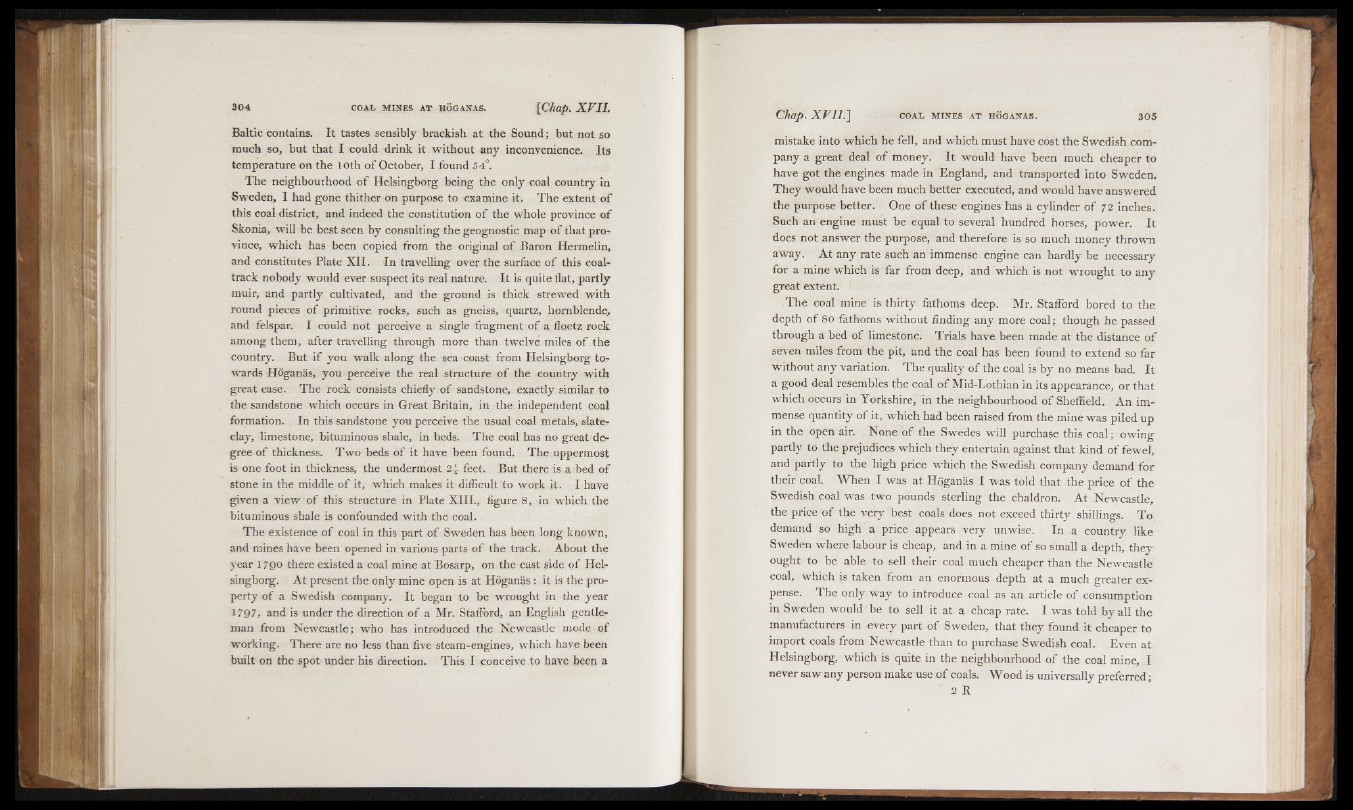
Baltic contains. It tastes sensibly brackish at the Sound; but not so
much so, but that I could drink it without any inconvenience. Its
temperature on the loth o f October, I found 54°.
The neighbourhood o f Helsingborg being the only coal country in
Sweden, I had gone thither on purpose to examine it. The extent o f
this coal district, and indeed the constitution of the whole province of
Skonia, will be best seen by consulting the geognostic map of that province,
which has been copied from the original o f Baron Hermelin,
and constitutes Plate XII. In travelling over the surface of this coal-
track nobody would ever suspect its real nature. It is quite flat, partly
muir, and partly cultivated, and the ground is thick strewed with
round pieces of primitive rocks, such as gneiss, quartz, hornblende,
and felspar. I could not perceive a single fragment o f a floetz rock
among them, after travelling through more than twelve miles of the
country. But i f you walk along the sea coast from Helsingborg towards
Hoganas, you perceive the real structure of the country with
great ease. The rock consists chiefly of sandstone, exactly similar to
the sandstone which occurs in Great Britain, in the independent coal
formation. In this sandstone you perceive the usual eoal metals, slate-
clay, limestone, bituminous shale, in beds. The eoal has no great degree
of thickness. Two beds o f it have been found. The uppermost
is one foot in thickness, the undermost 2~ feet. But there is a bed of
stone in the middle of it, which makes it difficult to work it. I have
given a view o f this structure in Plate XIII., figure 8, in which the
bituminous shale is confounded with the coal.
The existence o f coal in this part of Sweden has been long known,
and mines have been opened in various parts o f the track. About the
year 1790 there existed a coal mine at Bosarp, on the east side of Helsingborg.
At present the only mine open is at Hoganas: it is the property
o f a Swedish company. It began to be wrought in the year
1797, and is under the direction o f a Mr. Stafford, an English gentleman
from Newcastle; who has introduced the Newcastle mode of
working. There are no less than five steam-engines, which have been
built on the spot under his direction. This I conceive to haye heen a
mistake into which he fell, and which must have cost the Swedish company
a great deal o f money. It would have been much cheaper to
have got the engines made in England, and transported into Sweden.
They would have been much better executed, and would have answered
the purpose better. One o f these engines has a cylinder o f 72 inches.
Such an engine must be equal to several hundred horses, power. It
does not answer the purpose, and therefore is so much money thrown
away. At any rate such an immense engine can hardly be necessary
for a mine which is far from deep, and which is not wrought to any
great extent.
The coal mine is thirty fathoms deep. Mr. Stafford bored to the
depth o f 80 fathoms without finding any more coal; though he passed
through a bed of limestone. Trials have been made at the distance o f
seven miles from the pit, and the coal has been found to extend so far
without any variation. The quality o f the coal is by no means bad. It
a good deal resembles the coal of Mid-Lothian in its appearance, or that
which occurs in Yorkshire, in the neighbourhood of Sheffield. An immense
quantity of it, which had been raised from the mine was piled up
in the open air. None of the Swedes will purchase this coal; owing
partly to the prejudices which they entertain against that kind o f fewel,
and partly to the high price which the Swedish company demand for
their coal. When I was at Hoganas I was told that the price o f the
Swedish coal was two pounds sterling the chaldron. At Newcastle,
the price of the very best coals does not exceed thirty shillings. To
demand so high a price appears very unwise. In a country like
Sweden where labour is cheap, and in a mine of so small a depth, they
ought to be able to sell their coal much cheaper than the Newcastle
coal, which is taken from an enormous depth at a much greater expense.
The only way to introduce coal as an article o f consumption
in Sweden would be to sell it at a cheap rate. I was told by all the
manufacturers in every part of Sweden, that they found it cheaper to
import coals from Newcastle than to purchase Swedish coal. Even at
Helsingborg, which is quite in the neighbourhood of the coal mine, I
never saw any person make use of coals. Wood is universally preferred;
2 R